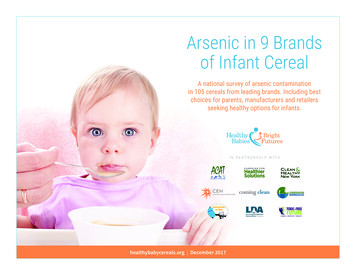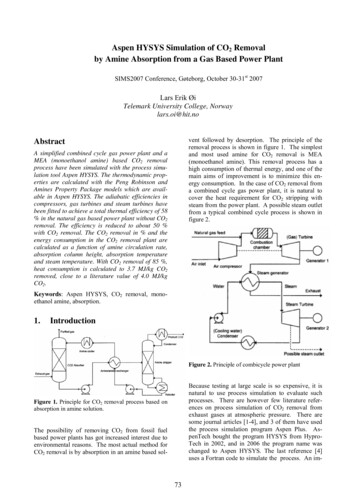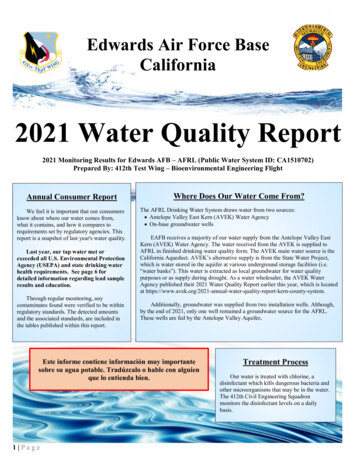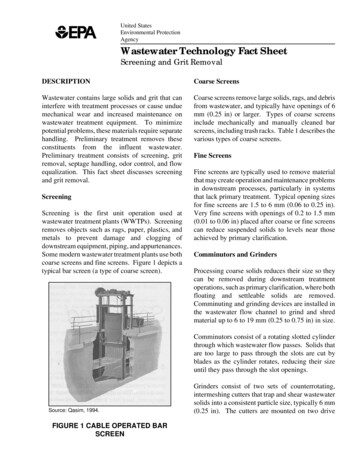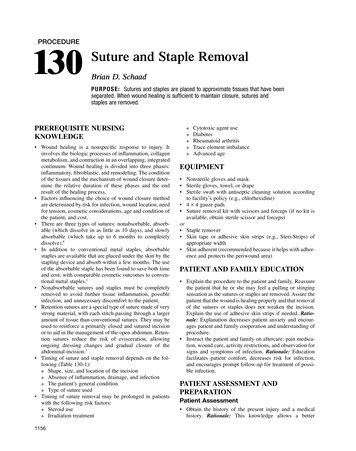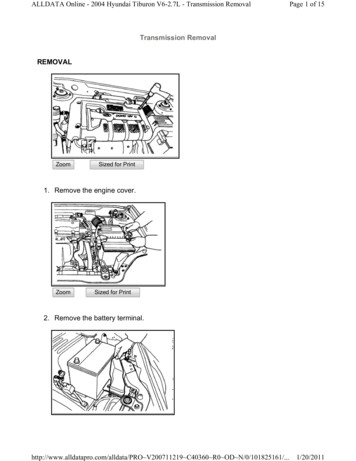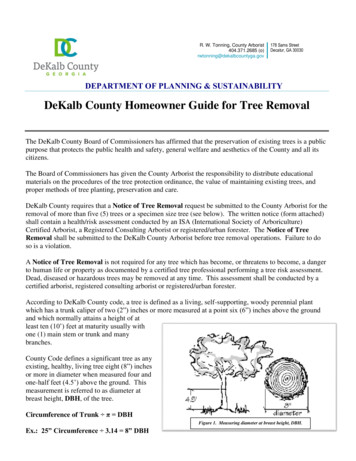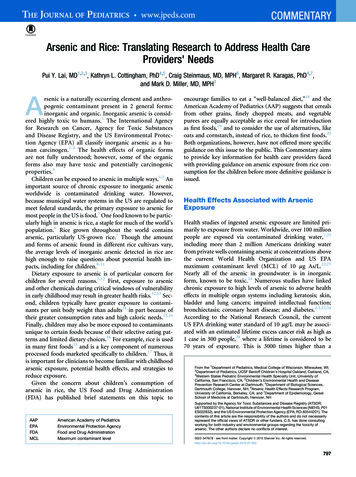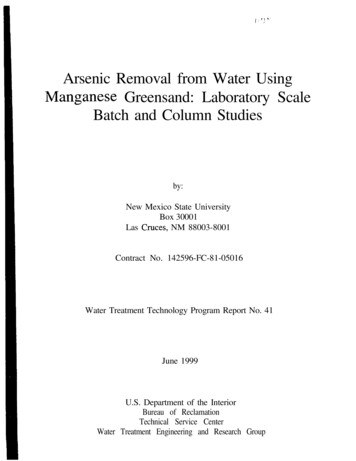
Transcription
Arsenic Removal from Water UsingManga,nese Greensand: Laboratory ScaleBatch and Column Studiesby:New Mexico State UniversityBox 30001Las Cruces, NM 88003-8001Contract No. 142596-FC-81-05016Water Treatment Technology Program Report No. 41June 1999U.S. Department of the InteriorBureau of ReclamationTechnical Service CenterWater Treatment Engineering and Research Group
REPORTDOCUMENTATIONPAGE6. FUNDINGNUMSERSArsenic Removal From Water Using Manganese Greensanrl:I&xatoly Scale Batch and Cohmm StudiesAssistance Agreement No142596-FC-81-05016s. AulnOR,S,Adrian Hanson, Jared Bates - NMSUICAGEDean Heil - CSU Soil ChemistryAndrew Bristol - NMSUiSWA? Lab7. PERFORMlNO-. --. .ORGANIZATION NAMEIS) AND ADDRESSIES,8. PERFORMlNGORGANlZATtONREPORT NUMBERNew Mexico State UniversityBox 3cwJlLas Cmces NM 88003-80019.SPONS0RINO NITORINOAAGENCY REPORT NUMBERBureau of ReclamationDenver Federal CenterPO Box 25007Denver CO 802250007WTTP Report No. 4 111. SUPPLEMENTARY N&-12a. MSTNIS”TION,A”AILASlLlTYSTATEMEMAvailable from the National Technical Information Service, Operations Division,5285 Port Royal Road, Springfield, Virginia 22161--Future drink&g water regulatiora for arsenic are expected to be lowered from the present 50 @gK to somewhere between 2 - 20 pg/LTwo rxer& studies inlkakd that manganese greensand could be very effective in removing ares&c. Manganese greensand is a mineraalIed glauccmite that is coated with a manganese oxide coating and used to remove iron and manganese hardness from drinking waterThis study evtid several important parameters for arsenic removal using manganese greensand.The parameters chosen to Inw&.atedwere contact time;. pH, iron concentration, anal potential of sulfate interference. In addition, b&b the common oxidation formBf aresenic, arsenite and arsenate, were studied. The greensand c&mm successfully removed arsenic, but only after the media hsrRwpf&mtedwithdihdencd.Jllsihlations areseni c IS present with both iron and manganese, this technology has great pmmiseI-14.SVSJECTTERMS--15. NVHSER OF PAGES
Arsenic Removal from Water UsingManganese Greensand: Laboratory ScaleBatch and Column Studiesby:New Mexico State UniversityBox 30001Las Cruces, NM 88003-8001Contract No. 1425-96-FC-81-05016Water Treatment Technology Program Report No. 41June 1999U.S. Department of the InteriorBureau of ReclamationTechnical Service CenterWater Treatment Engineering and Research Group
Mission StatementThe mission of the Department of the Interior is to protect and provide access to ourNation’s natural and cultural heritage and honor our trust responsibilities to tribes.The mission of the Bureau of Reclamation is m manage, develop, and protect water andrelated resources in an environmentally sound manner in the interest of the AmericanPublic.DisclaimerThe information contained in this report regarding commercial products or tinns may notbe used for advertising or promotional purposes and is not m be construed as anendorsement of any product or firm by the Bureau of Reclamation.The information contained in this report was developed for the Bureau of Reclamation: nowarranty as to the accuracy, usefulness, or completeness is expressed or implied.
ACKNOWLEDGMENTSThis research was funded in part through the Water Treatment technology Program Departmentof the Interior grant (solicitation no. 142%96-FC-81-05016).The authors would also like tothank the Waste Education Management and Research Consortium (WERC) for support throughtheir seed grant program, the Engineering Research Center NMSU, and the Engineering Collegeat NMSU.This work has been presented in a number of formats at a number of forums. The citations arelisted below.Bates, J., A. Hanson, D. Heil, M. Johnson, G. Rayson, A. Bristol, Manganese Greensandfor the Removal of Arsenic From Drinking Water, AWWA Water Quality TechnologyConference, San Diego, California, November 1 - 5, 1998.Bates, J., A. Hanson , D. Heil, M. Johnson, G. Rayson, A. Bristol, Batch studies ofArsenic Removal From Drinking Water Using Manganese Greensand, AWWA AnnualNational Conference, Dallas TX, June 21-25, 1998 (Third Place Poster).A. Hanson , D. Heil, J. Bates, M. Johnson, G. Rayson, A. Bristol, Removal of ArsenicFrom Drinking Water Using Manganese Dioxide Coated Filter Media, AWWAInorganics Workshop, San Antonio TX, February 23, 1998.Bates, J., A. Hanson, F. Cadena, B. Thomson, A. Bristol, Technologies for the Removalof Arsenic From Drinking Water in New Mexico, New Mexico Science Journal, 1998.Bates, J., Batch Studies of Arsenic Removal From Drinking Water Using ManganeseGreensand, Masters Thesis, New Mexico State University, May, 1998.
EXECUTIVE SUMMARYFuture drinking water regulations for arsenic arc expected to be lowered from the present50 ug/L to somewhere between 2 and 20 ug/L. Two recent studies have indicated that manganesegreensand could be very effective in removing arsenic. Manganese greensand is a mineral calledglauconite that is coated with a manganese oxide coating and used to remove iron and manganesehardness from drinking water.The purpose of this study is to evaluate several important parameters for arsenic removal usingmanganese greensand. The parameters chosen to be evaluated were contact time, pH, ironconcentration, and potential of sulfate interference. In addition both of the common oxidationforms of arsenic, arsenite and arsenate, were studied.The experimental procedure was carried out under laboratory conditions. Adjustment of pH wasaccomplished by the addition of acid or base. Iron-arsenic solutions were mixed for ten minutes.One gram of manganese greensand was added to solution and mixed for the contact time desired.The solution was filtered to separate the liquid phase from the sand. The solution was analyzedby a commercial 1,ab using inductively coupled plasma mass spectrophotometery with a detectionlimit for arsenic of ti.4 ug/L.A range of pH’s from 3 to 9 was evaluated. A pH of 5 was found to be optimal for arsenicremoval in the arsenate and arsenite form. For an initial arsenic concentration of 50 ug/L, thefinal arsenic concentration ranged from 1.8 pg/L to 4.2 pg/L for a pH of 5. Two more batch setswere performed at this optimal pH with similar results. Varying ferrous chloride concentrationswere added to the solution from zero to 20 times the arsenic concentration in terms of molar ratioof ferrous chloride to arsenic. At all the pHs no significant correlation between iron dose andarsenic removal can be seen. Contact times from 15 minutes to 24 hours were evaluated at a pHof 5. The results indicate that arsenic adsorption to manganese greensand has reached itsmaximum by 15 minutes of contact time. Sulfate interference was evaluated at a pH to 5. Basedon the results from the batch testing, sulfate did not interfere with arsenic removal.The greensand columns successfully removed arsenic, but only after the media had been pretreated with dilute acid. A solution of dilute HCI was passed through the media until the influentand effluent pH came to steady state. This allowed the operator to control the operational pH.With the bed properly prepped, 400 bed-volumes of water were treated with no evidence ofimpending breakthrough. The bed was regenerated and another 200 bed-volumes were treated.It appears that the appropriate preparation of the media will allow manganese greensand to act asan effective arsenic removal media. It appears that neither BlRM nor Anthrasand is an adequatereplacement for manganese greensand.i
There are a number of simple technologies, such as ion exchange, coagulation/microtiltration,iron oxide based filtration, and activated alumina, which are on the market for treatment ofarsenic in water. In a situation where only arsenic is to be removed, or where arsenic andfluoride are to be removed, the technology discussed here is probably not cost effective.However, in a situation where Fe & Mn are present with As this technology has great promise.This technology is especially interesting to utilities where Fe and Mn are already being removedusing a manganese greensand filter. It is possible that a small pH adjustment from 8 to 6.5 maybe all that is required to bring the facility into compliance.ii
TABLE OF CONTENTSPageNo.LISTOFTABLES. . . . . . . . . . . . . . . . . . . . . . . . . . . . . . . . . . . . . . . . . . . . . . . . . . . . . . . . . . . . viLISTOFFIGURES. . . . . . . . . . . . . . . . . . . . . . . . . . . . . . . . . . . . . . . . . . . . . . . . . . . . . . . . . . vii1. INTRODUCTION . . . . . . . . . . . . . . . . . . . . . . . . . . . . . . . . . . . . . . . . . . . . . . . . . . . . . . . .1.1 Arsenic Background . . . . . . . . . . . . . . . . . . . . . . . . . . . . . . . . . . . . . . . . . . . . . . .1.1 .l Arsenic Chemistry . . . . . . . . . . . . . . . . . . . . . . . . . . . . . . . . . . . . . . . . .1.1 .2 Drinking Water Regulations . . . . . . . . . . . . . . . . . . . . . . . . . . . . . . . . .1 .I .3 Health Implications of Arsenic . . . . . . . . . . . . . . . . . . . . . . . . . . . . . . .1.1.4 Occurrences of Arsenic . . . . . . . . . . . . . . . . . . . . . . . . . . . . . . . . . . . . .1.15 Arsenic Removal Techniques . . . . . . . . . . . . . . . . . . . . . . . . . . . . . . . .1.1.5.1 Iron Coagulation . . . . . . . . . . . . . . . . . . . . . . . . . . . . . . . . . . .1.1.5.2 Alum Coagulation . . . . . . . . . . . . . . . . . . . . . . . . . . . . . . . . . .1.1.5.3 Softening . . . . . . . . . . . . . . . . . . . . . . . . . . . . . . . . . . . . . . . . .1.1.5.4 Activated Alumina Filtration . . . . . . . . . . . . . . . . . . . . . . . . .1.2 Manganese Greensand Filtration Background . . . . . . . . . . . . . . . . . . . . . . . . . . .1.2.1 Glauconite Background . . . . . . . . . . . . . . . . . . . . . . . . . . . . . . . . . . . . .1.2.2 Manganese Dioxide Background . . . . . . . . . . . . . . . . . . . . . . . . . . . . . .1.2.3 Potassium Permanganate Background . . . . . . . . . . . . . . . . . . . . . . . . . .1.2.4 Manganese Greensand Filtration . . . . . . . . . . . . . . . . . . . . . . . . . . . . . .1.2.4.1 Chemistry . . . . . . . . . . . . . . . . . . . . . . . . . . . . . . . . . . . . . . . .1.2.4.2 Typical Physical Characteristics and Operating Parameters .1.2.4.3 Full Scale Arsenic Removal Study1.2.4.4 Pilot Scale Arsenic Removal Study . . . . . . . . . . . . . . . . . . . .1.3 Objectives . . . . . . . . . . . . . . . . . . . . . . . . . . . . . . . . . . . . . . . . . . . . . . . . . . . . . . .2. MATERIALS AND METHODS . . . . . . . . . . . . . . . . . . . . . . . . . . . . . . . . . . . . . . . . . . . .2.1 Chemicals and Media Used . . . . . . . . . . . . . . . . . . . . . . . . . . . . . . . . . . . . . . . . .2.1.1 Arsenate Solution . . . . . . . . . . . . . . . . . . . . . . . . . . . . . . . . . . . . . . . . . .2.1.2 Arsenite Solution . . . . . . . . . . . . . . . . . . . . .2.1.3 Ferrous Iron Solution . . . . . . . . . . . . . . . . . . . . .2.1.4 Potassium Permanganate Solution . . . . . . . .2.1.5 Manganese Greensand . . . . . . . . . . . . . . . . .2.2 Experimental Procedure . . . . . . . . . . . . . . . . . . . . . . .2.2.1 Pre-Treatment of Glassware and Test Tubes2.2.2 Optimum pH and Fe Dose . . . . . . . . . . . . . .2.2.3 Optimum Contact Time . . . . . . . . . . . . . . . .2.2.4 Sulfate Interference . . . . . . . . . . . . . . . . . . . . . . . .2.2.5 Arsenite Study . . . . . . . . . . . . . . . . . . . . . . .3. RESULTS AND DISCUSSION . . . . . . . . . . . . . . . . . . . . . . . .3.1 OptimumpHandFeDose3.2 Optimum Contact Time . . . . . . . . . . . . . . . . . . . . . . .3.3 Sulfate Interference . . . . . . . . . . . . . . . . . . . . . . . . . . . .11112455666771 .19.19.21.21.30.32
Table of ContentsPage No.3.4 ArseniteStudy.343.5 Chemical Models . . . . . . . . . . . . . . . . . . . . . . . . . . . . . . . . . . . . . . . . . . . . . . . . .37.413.5.3 Ion Exchange Model .4. COLUMN STUDIES . . . . . . . . . . . . . . . . . . . . . . . . . . . . . . . . . . . . . . . . . . . . . . . . . . . . .475. A L T E R N A T E M A N G A N E S E D I O X I D E C O A T E D M E D I A . . 1. .5 15.1BlRMMedia . . . . . . . . . . . . . . . . . . . . . . . . . . . . . . . . . . . . . . . . . . . . . . . . . . . . .515.2AnthrasandMedia.536. CONCLUSIONS.55REFERENCES . . . . . . . . . . . . . . . . . . . . . . . . . . . . . . . . . . . . . . . . . . . . . . . . . . . . . . . . . . . .57APPENDICESBATCH TESTS: EFFECT OF FE AND PHBATCH TESTS: EFFECT OF CONTACT TIMEBATCH TESTS: EFFECT OF SULFATEBATCH TESTS: EFFECT OF USING ARSENITE INSTEAD OF ARSENATEFREUNDLICH ISOTHERMS FOR VARIED PHLANGMUIR ISOTHERMS FOR VARIED PHCOLUMN TESTSARSENIC REMOVAL TECHNOLOGIES PAPERBATES, J., A. HANSON, F. CADENA, B. THOMSON, A. BRISTOL,TECHNOLOGIES FOR THE REMOVAL OF ARSENIC FROM DRINKINGWATER IN NEW MEXICO, NEW MEXICO SCIENCE JOURNAL, 1998LIST OF TABLESTable 1:Table 2:Table 3:Table 4:Table 5:Table 6:Table 7:Table 8:Table 9:Summary of Arsenic Regulation in the U.S. (summarized from Pontius)Typical Arsenic Concentrations in Various Materials . . . .Typical Greensand Physical Properties (Inversand) . . . . .Typical Operating Parameters for Manganese Greensand Filters (Inversand)Arsenic Removal using Manganese Greensand in Kelliher, Saskatchewan(Magyar,1992) . . . . . . . . . . . . . . .Summary of Freundlich Constants From Figure 31 . . . .Summary of Freundlich Constants From Figure 32 .S u m m a r y o f Langmuir C o n s t a n t s F r o m F i g u r e 3 3 . . .Summary of Langmuir Constants From Figure 34 . . . . . . .iv2413. 13. . .143636::41.41
LIST OF FIGURESPage 13:14:15:16:17:18:19:20:Figure 21:Figure 22:Figure 23:Figure 24:Figure 25:Figure 26:Figure 27:Figure 28:Figure 29:Figure 30:Figure 3 1:Figure 32:Figure 33:Figure 34:Figure 35:Idealized Structure of Glauconite (from Nesse, 1991) . . . . . . . . . . . . . . . . . . . . . . .8Scanning Electron Microscope Photograph of Greensand Particles . . . . . . . . . . . . .9Scanning Electron Microscope Elemental Analysis of Greensand Surface . . . . . . . 9Idealized Schematic of Manganese Dioxide Ion Exchange (Posselt, Anderson, andWeber,1968) . . . . . . . . . . . . . . . . . . . . . . . . . . . . . . . . . . . . . . . . . . . . . . . . . . . . . . 1 0Final Arsenic Concentrations @g/L) at a pH of 3 .21Final Arsenic Concentrations @g/L) at a pH of 5 . . . . . . . . . . . . . . . . . . . . . . . . .22.Final Arsenic Concentrations @g/L) at a pH of 6.22Final Arsenic Concentrations (ug/L) at a pH of 7 . . . . . . . . . . . . . . . . . . . . . . . . .23FinalArsenicConcentrations@g/L)atapHof9.23Final Arsenic Concentrations (pg/L) at an Initial As Cont. of 500 ug/L . . . . . . . . . 2 4Final Arsenic Concentrations @g/L) at an Initial As Cont. of 200 ug/L . . . . . . . . .24Final Arsenic Concentrations @g/L) at an Initial As Cont. of 100 ug/L . . . . . . . . . 25Final Arsenic Concentrations @g/L) at an Initial As Cont. of 50 pg/L . . . . . . . . . .25Final Arsenic Concentrations @g/L) at an Initial As Cont. of 25 ug!L . . . . . . . . .26Final Arsenic Concentrations @g/L) at an Initial As Cont. of 10 pg/L 26Final Arsenic Concentrations @g/L) at an Initial As Cont. of 5 pg/L . . . . . . . . . . .27Arsenic Removal Percentages at a pH of 5 (FeCl,:As molar ratio of 20) . . . . . . . .28Arsenic Removal Percentages at a pH of 5 (FeCl,:As molar ratio of 5) . . . . . . . . .28Arsenic Removal Percentages at a pH of 5 (FeCl,:As molar ratio of 0) . . . . . . . . .28Difference in As Removal Percentages at a pH of 5 between set l:(FeCl,:As molarratio of 20) & set 2:(FeCl,:As molar ratio of 0) . . . . . . . . . . . . . . . . . . . . . . . . . . . .29Arsenic Removal Percentages at a pH of 5 (considering iron has no effect, 95%confidencelevel). . . . . . . . . . . . . . . . . . . . . . . . . . . . . . . . . . . . . . . . . . . . . . . . . .2 9Final Arsenic Concentrations @g/L) for Varied Contact Times (for pH of 5 andinitialAsconcof5pg/L). . . . . . . . . . . . . . . . . . . . . . . . . . . . . . . . . . . . . . . . . . . .30Final Arsenic Concentrations @g/L) for Varied Contact Times (for pH of 5 andinitialAsconc.of50pg/L) . . . . . . . . . . . . . . . . . . . . . . . . . . . . . . . . . . . . . . . . . .3 IFinal Arsenic Concentrations @g/L) for Varied Contact Times (for pH of 5 andinitialAsconc.of5OOpgk) . . . . . . . . . . . . . . . . . . . . . . . . . . . . . . . . . . . . . . . . . .31Final Arsenic Concentrations @g/L) at a pH of 5 (sulfate ion present) . . . . . . . . . . 3 2Final Arsenic Concentrations @g/L) at a pH of 5 (chloride ion present) . . . . . . . . . 33Difference in Arsenic Removal % at a pH of 5 between set l:(chloride ion present) &set 2:(sulfate ion present) . . . . . . . . . . . . . . . . . . . . . . . . . . . . . . . . . . . . . . . . . . . . .33Arsenite Study (Initial Arsenic Cont. of 5 pg/L) . . . . . . . . . . . . . . . . . . . . . . . . . . .34Arsenite Study (Initial Arsenic Cont. of 50 ug/L) . . . . . . . . . . . . . . . . . . . . . . . . .35Arsenite Study (Initial Arsenic Cont. of 500 pg/L) . . . . . . . . . . . . . . . . . . . . . . . . .35FreundlichIsothermsforVariedpHs.37Freundlich Isotherms, pH 5 for three sets . . . . . . . . . . . . . . . . . . . . . . . . . . . . . . . . 37Langmuir Isotherms for Varied pHs . . . . . . . . . . . . . . . . . . . . . . . . . . . . . . . . . . . . .40Langmuir Isotherms, pH 5 for three sets . . . . . . . . . . . . . . . . . . . . . . . . . . . . . . . . . 40Zero Point of Charge of Ferric Hydroxide (Peng and Di,1994) . . . . . . . . . . . . . . . .42V
LIST OF FIGURESPage gure 41:Figure 42:Figure 43:FigureFigureFigureFigure44:45:46:47:pC-pH diagram for a 10e6.‘M (5Opg/L) solution of Arsenate . . .DistributionDiagramforArsenate.pC-pH diagram for a 1tY6.‘M (5OpgiL) solution of Arsenite .DistributionDiagramforArsenite.Manganese greensand filter used to treat As contaminated water. No specialcolumn preparation. Influent pH adjusted to 6.0. Filter rate of 2 gpm/f?. Filtermedia depth 6inches . . . . . . . . . . . . . . . . . . . . . . . . . . . . . . . . . . . . . . . . . . . . . . .Manganese greensand filter used to treat As contaminated water. No specialcolumn preparation. Influent pH adjusted to 6.0. Filter rate of 2 gpm/ft*.Filtermediadepth18inches.Manganese greensand filter used to treat As contaminated water. Column pHpre Adjusted prior to As removal. Ii&tent and Effluent pH adjusted to 5.5.Filterrate2 gpm/ft*. Filter media depth 13 in . . .Regenerated manganese greensand filter used to treat As contaminated water.Column pH pre Adjusted prior to As removal. Influent and Effluent pHadjusted to Filter rate 2 gpm/ft’. Filter media depth 13 in. . . . .Photomicrograph of the BIRM media .EDAXspectrumfortheBIRMmedia.Photomicrograph of Antbrasand media, a proprietary General Filter ProductEDAX spectrum for the Anthrasand media, a proprietary General Filter Productvi43: 43.44.44.47.48.4849:5152:53.53
1. INTRODUCTION1.1 Arsenic Background1.1 .l Arsenic ChemistryArsenic is Group 15 element. It is usually classified as a non-metal with some metallicproperties. It has an a,tomic number of 33 and an atomic mass of 74.92. It is odorless, tasteless,and highly toxic. These three characteristics made arsenic the perfect poison in medieval times.Inorganic arsenic can exist in four oxidation states: 5, 3, 0, -3. The two inorganic forms mostprevalent in aqueous chemistry are the pentavalent arsenate ion, (As[V]), and the trivalentarsenite ion, (As[UI]). Organic forms of arsenic also exist that contribute to total arsenic, but theyare probably not significant in most drinking water sources and are therefore not considered inthis research.1 .1.2 Drinking Water RegulationsThe regulation of arsenic in drinking water has been continually evolving for half a century. Thelimits for arsenic in drinking water continue to be hotly debated in scientific and legislativecircles because of the potential cost (in terms of treatment or in terms of health care) to theAmerican public. Table 1 summarizes some of the important events relating to arsenic regulationin the United States.In 1942 the Public Health Service set a maximum permissible concentration for arsenic at50 pg/L, based on existing data on the acute, short-term toxic effects, which were well knownbecause of the use of arsenic as a poison over the past 4000 years (Pontius,l994). This standardwas adopted by many of the states, but was relatively unenforceable because the Public HealthService had no national enforcement powers. The standard was reaffirmed by the Public HealthService in the water quality standards adoptions of 1946 and 1962 (Pontius,l994).The 1974 Safe Drinking Water Act required the recently created U.S. Environmental ProtectionAgency (EPA) to set enforceable standards for health related drinking water contaminants thatwere to apply to all public water systems. In 1975, the EPA set the interim maximumcontaminant level (MCL) for arsenic at 50 pg/L, based in part on the 1962 USPHS standard(Pontiusl994). The standard for arsenic has remained at 50 pg/L since that time, but there hasbeen much debate over whether to lower it.The Safe Drinking Water Act Amendments of 1996 require a tinal National Public DrinkingWater Regulation (NPDWR) for arsenic must be proposed by January 1,200O and promulgatedby January 1, 2001. This regulation will be based on current research to “reduce the uncertaintyin assessing health risks associated with exposure to low levels of arsenic.” (Pontius, 1997). Therange of values under consideration is from 2 ug/L to 20 ug/L as total arsenic.
Table 1: Summary of Arsenic Regulation in the U.S. (summarized from Pontius)1942 1 Public Health Service (PHS) sets arsenic standard at 50 ug/L in drinking water.1946 1 PHS reaffirms amen ic standard.1962 1 PHS reaffirms arsenic standal ‘d.I 1968 I Tsena ot lblishes oaper. “Prevalence of Skin Cancer in an Endemic Area ofChronic Arsenicism’in Taiwan.”1970 Environmental Protection Agency (EPA) is created.1974 Safe Drinking Water Act created, require EPA to set and enforce drinking waterstandards.1975 Interim Primary Drinking Water Standard MCL for arsenic set at 50 ug/L.1977 Tsena publishes paper, “Effects and Dose-Response Relationships of SkinCancer and Blackfoot Disease With Arsenic.”19831EPAreport concludes that studies up to that point lacked sufficient statisticalt-Ipower to definitively determine whether arsenic causes skin cancer.1985 EPA proposes a recommended MCL of 50 ug/L.1986 Amendments to the SDWA rename the RMCL as the MCL goal and requireEPA to set a MCL and a MCLG for arsenic by 1989.1988 EPA panel concludes that more research is needed on threshold effects.1989 Bull Run Coalition files suit against EPA for missing MCL deadline. Newdeadline set for 1991.1991 EPA misses deadline. decides no further research is needed, and must proposeMCL’s by November i 992.1992 Two new studies re-evaluating old data show a high correlation between arsenicin drinking water and cancer. EPA misses deadline.,1994 EPA misses deadline.1995 EPA misses deadline.1996 Amendments to the SDWA require a proposed standard for arsenic by January1,2000, and a standard be promulgated by January 1,200l.International standards have generally been 50 ug/L, but other countries are looking at loweringtheir standards also. In 1993, the World Health Organization (WHO) recommended a provisionalguideline value of 10 pg/L based on both estimated health risks and the practical detection limit(Weston, 1997). Recently the German standard for arsenic has been lowered to 10 pg/L (Weston,1997).1 .1.3 Health Implications of ArsenicArsenic occurs naturally, being the twentieth most abundant element in the earths crust (Pontius,Brown, and Chen, 1994). Humans are exposed to arsenic primarily through air, food, or water(Pontius, Brown, and Chen, 1994). Exposure through air is negligible unless the area is heavilypolluted by smelters or power plants (Pontius, Brown, and Chen, 1994). Exposure to arsenicthrough food ingestion is significant. “Based on market-basket surveys of the total arseniccontent in United States food, the US Food and Drug Administration has estimated that adultsingest an average of about 53 pg/day of arsenic from the diet” (Pontius, Brown, and Chen, 1994).EPA estimates that only twenty percent of the arsenic in food, or 10 pg/day, is inorganic arsenic,2
which is the most toxic form of arsenic (Pontius, 1994). Ingestion of inorganic arsenic indrinking water thus possibly becomes the largest source of exposure to the toxic and carcinogeniceffects of arsenic if the arsenic concentration in the water is more than 5 pg/L, assuming an adultdrinks two liters of water per day.Three possible types of health effects exist for exposure to arsenic. The first effect is toxic effectsdue to short term, acute exposure to larger amounts of arsenic. The second effect is toxic effectsdue to long term, chronic exposure to smaller amounts of arsenic. The third effect is increasedrisk of cancer due to long term, chronic exposure to smaller doses of arsenic. The carcinogeniceffect is probably the controlling factor in determining how low to set the drinking waterstandard for arsenic (Pontius, Brown, and Chen, 1994). Complicating this is the fact that eachspecies of arsenic has a different toxicity.Studies of organic arsenic excretion suggest that doses of inorganic arsenic up to around200 pg/day are detoxified, but the validity of the studies was questioned by other scientists(Pontius, Brown, and Chen, 1994). Scientists have suggested that arsenic could actually be atrace nutrient essential to human heahh. “Studies with minipigs, goats, chicks, hamsters, and ratshave indicated that it is an essential nutrient” (Pontius, Brown, and Chen, 1994). Data onhumans is insufficient to determine essentiality, but it remains a hotly contested subject. Uthushas suggested that a daily intake of 12 to 40 pg of inorganic arsenic would constitute a safe andadequate dietary intake (Pontius, Brown, and Chen, 1994). Subtracting the 10 ug/daycontributed by food, the safe level of arsenic in drinking water would be as high as 15 pg/L,assuming an adult would drink 2 liters per day, based on short term toxic effects.The EPA has used similar reasoning to calculate a maximum level for arsenic based on chronictoxic effects. The value calculated is between 4 to 28 pg/L, depending on the safety factor used(Pontius, Brown, and Chen, 1994). Subtracting the 10 pg/day contributed by food, the safe levelof arsenic in drinking water would be as high as 9 pg/L, assuming an adult drinks 2 liters per day.The studies in Taiwan linked arsenic with skin cancer. Later studies have also indicated links tointernal cancers. One of the most recent studies done in Argentina indicated that people whodrank from water wells with an average arsenic concentration of 179 pg/L, had an incidence ofbladder cancer twice the national average (Raloff, 1996). The data is still being reviewed andrestudied in that case.Statistical studies in the United States and also in Hungary show no positive correlations betweenarsenic and cancer. Several explanations can be made. One of the more interesting thoughts isthat perhaps arsenic acts more as a promoter of cancer, rather than an initiator (Pontius, Brown,and Chen, 1994). This means that other factors in the Taiwanese study, (such as malnutrition, agenetic tendency for cancer, or other contaminants in the water), may have contributed to thehigh cancer rate, and that the arsenic exposure amplified the number of cancer cases in thepresence of these other factors (Pontius, Brown, and Chen, 1994).The cancer risk is extrapolated from a model which assumes that the dose-response relationshipis linear at low doses. Statistically this is invalid because no data exist at low levels and thus noconfidence IeveIs exist. Based on the skin cancer studies in Taiwan. the EPA calculated that a3
maximum level of 2 pg/L of arsenic would satisfy the risk requirement of one excess death in alifetime out of ten thousand people (1: 10,000) (Pontius, Brown, and Chen, 1994). One of thequestionable assumptions is that the Taiwanese population is similar to the U.S. population.Studies are continuing that mostly focus on the cancer effects of arsenic. These studies will beused to set the arsenic limit for drinking water in 2001.1 .1.4 Occurrences of ArsenicThe occurrence of arsenic can be associated with natural conditions or the industrial practices ofmankind. Being a basic element, the occurrence of arsenic is worldwide, but is moreconcentrated in some geographic regions. Natural arsenic is generally associated withsedimentary rocks of marine origin, weathered volcanic rocks, fossil fuels, and geothermal areas(Korte and Fernando, 1991). Arsenic readily substitutes for silicon, ferric iron, and aluminum incrystal lattices of silicate minerals, and therefore, it is possible for it to occur in all geologicalmaterials (Korte and Fernando, 1991). Mankind’s activities have caused higher concentrations ofarsenic to result in some places. Arsenic is associated with mining wastes, agricultural uses,wood preservation, and irrigation practices (Korte and Fernando, 1991) Some typicalconcentrations of arsenic in various materials are given in Table 2.In general, arsenic occurs in higher levels in the southwestern United States and along thewestern coa
Arsenic Removal from Water Using Manga,nese Greensand: Laboratory Scale Batch and Column Studies by: New Mexico State University Box 30001 Las Cruces, NM 88003-8001 Contract No. 142596-FC-81-05016 Water Treatment Technology Program Report No. 41 June 1999 U.S. Department of the Interior Bureau of Reclamation Technical Service Center
